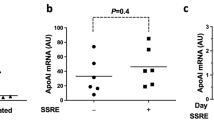Abstract
Efficient transfection conditions for a number of human, rat and rabbit primary cells and established lines of vascular origin have been determined using a complex of a commercially available cationic lipid transfection agent (Tfx™-50) and luciferase reporter plasmid constructs. The optimised conditions have also been successfully applied to rabbit carotid arteries in vivo and a series of human arteries in vitro. The most critical factors influencing the efficiency of gene transfection with this protocol are: DNA concentration; ratio of lipid reagent to DNA; transfection time and the presence or absence of serum. Immunohistochemical analysis shows that a high percentage of cells (approximately 30–80% dependent on lineage) were transfected under optimal conditions with minimal toxicity effects. Similar analyses performed on undamaged rabbit carotid vessels transfected in vivo and human arteries transfected in vitro show high-efficiency transfer and strong expression of the luciferase vector as demonstrated by reporter gene expression. The optimisation of gene transfer into vascular cells with this cationic lipid complex will be valuable for molecular studies of genes implicated in cardiovascular diseases and as a possible method of gene delivery with therapeutic intent.
Similar content being viewed by others
Author information
Authors and Affiliations
Rights and permissions
About this article
Cite this article
Keogh, MC., Chen, D., Lupu, F. et al. High efficiency reporter gene transfection of vascular tissue in vitro and in vivo using a cationic lipid–DNA complex. Gene Ther 4, 162–171 (1997). https://doi.org/10.1038/sj.gt.3300374
Received:
Accepted:
Issue Date:
DOI: https://doi.org/10.1038/sj.gt.3300374
- Springer Nature Limited
Keywords
This article is cited by
-
Timing and duration of lipofection-mediated CRISPR/Cas9 delivery into porcine zygotes affect gene-editing events
BMC Research Notes (2021)
-
Prevention of restenosis using the gene for cecropin complexed with DOCSPER liposomes under optimized conditions
International Journal of Angiology (2011)
-
Prevention of restenosis by a herpes simplex virus mutant capable of controlled long-term expression in vascular tissue in vivo
Gene Therapy (2001)
-
Antisense oligonucleotides directed against the viral RNA polymerase gene enhance survival of mice infected with influenza A
Nature Biotechnology (1999)
-
Tissue-selective expression of dominant-negative proteins for the regulation of vascular smooth muscle cell proliferation
Gene Therapy (1999)




